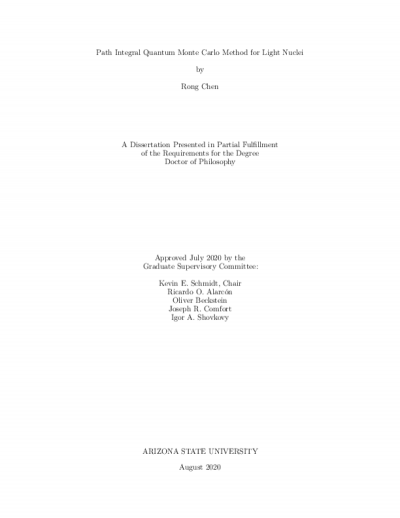Path Integral Quantum Monte Carlo Method for Light Nuclei

Description
I describe the first continuous space nuclear path integral quantum Monte Carlo method, and calculate the ground state properties of light nuclei including Deuteron, Triton, Helium-3 and Helium-4, using both local chiral interaction up to next-to-next-to-leading-order and the Argonne $v_6'$ interaction. Compared with diffusion based quantum Monte Carlo methods such as Green's function Monte Carlo and auxiliary field diffusion Monte Carlo, path integral quantum Monte Carlo has the advantage that it can directly calculate the expectation value of operators without tradeoff, whether they commute with the Hamiltonian or not. For operators that commute with the Hamiltonian, e.g., the Hamiltonian itself, the path integral quantum Monte Carlo light-nuclei results agree with Green's function Monte Carlo and auxiliary field diffusion Monte Carlo results. For other operator expectations which are important to understand nuclear measurements but do not commute with the Hamiltonian and therefore cannot be accurately calculated by diffusion based quantum Monte Carlo methods without tradeoff, the path integral quantum Monte Carlo method gives reliable results. I show root-mean-square radii, one-particle number density distributions, and Euclidean response functions for single-nucleon couplings. I also systematically describe all the sampling algorithms used in this work, the strategies to make the computation efficient, the error estimations, and the details of the implementation of the code to perform calculations. This work can serve as a benchmark test for future calculations of larger nuclei or finite temperature nuclear matter using path integral quantum Monte Carlo.
Date Created
The date the item was original created (prior to any relationship with the ASU Digital Repositories.)
2020
Agent
- Author (aut): Chen, Rong
- Thesis advisor (ths): Schmidt, Kevin E
- Committee member: Alarcon, Ricardo O
- Committee member: Beckstein, Oliver
- Committee member: Comfort, Joseph R.
- Committee member: Shovkovy, Igor A.
- Publisher (pbl): Arizona State University

